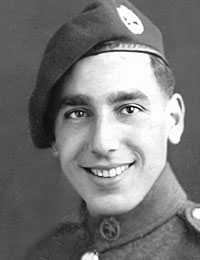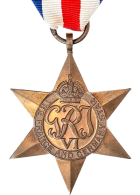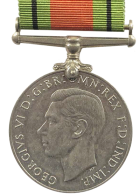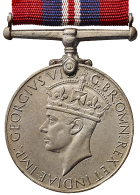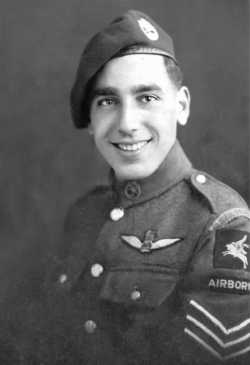Frank Ashleigh was born on the 23rd December 1924 in Collingwood Street, east London, a true Cockney. The family, mother, father and elder sister moved to Stamford Hill, north London in 1927. He was educated, first at Castlewood Road primary school and then, having passed the Junior County examination, (forerunner to the 11 plus) at Upton House. April 1939 saw the family move again to Childs Hill in north-west London and his leaving school at the tender age of 14.
Deciding he needed training to enable him to earn a living, he was apprenticed to firm manufacturing equipment for dental surgeries. After a few months he decided that this was not for him and he left and engaged on a course to learn arc welding with a company named Actarc, whose working name was Active Arc, manufacturers of arc-welding equipment and welding rods. With today's knowledge they could not produce those rods as, instead of being flux coated they were wound with asbestos as an anti-oxidant.
Then came his introduction to the military when he joined the 1st. Cadet battalion Royal Fusiliers, rising to the dizzy rank of Corporal. September '39 saw the outbreak of war and his going to work at T.C. Jones, part of the George Cohen 600 group of engineers and then on to Strachans Ltd. In Park Royal a firm of coachbuilders. They were impressed with his welding skill, and through them he became an A.I.D. (Aircraft Inspection Department) approved welder.
On his 18th birthday he volunteered for the army. Being in a reserved occupation, release was opposed by Strachans as they were engaged in the building of military vehicles, but eventually they did release him and the following February he received his calling-up papers to report to Arnold camp in Nottingham for primary training. Having completed the course and being considered a 'trained soldier' he was posted to R.E.M.E. and sent to Woolwich Arsenal to await final posting. This did not come for a considerable period as the authorities thought he might benefit from a course to learn to weld, so it was off to Letchworth Garden City to learn arc welding and then to the British Oxygen Company in Cricklewood to learn gas welding, skills in which he was already proficient, having learned gas welding at Strachans.
He was finally posted to the Odeon Garage in Southend on Sea, where, because he was a Craftsman with welding skills, he was made a Regimental Policemen with duties of logging the comings and goings of a fleet of Dodge three tonners, though where they went and what they did when they got there he never knew. It was there that he read that applications were invited to join the Glider Pilot Regiment.
Together with two of his friends, Norman Kellet and Albert Heptinstall, both from Yorkshire, he put his name down and they were sent to London for 'flying aptitude' assessment. Frank was accepted but both of his friends were rejected. He subsequently received orders to report to Fargo Camp, Larkhill, on Salisbury Plain. On reporting there everybody was a little excited to see, on marching down the main road to see the words 'flying kit' on the door of a Nissan Hut. Then followed six weeks of mental and physical torture designed to weed the wheat from the chaff. The P.T. instructor was good but relentless. He was nicknamed 'Garth' after the Daily Mirror cartoon character. Each morning there would be a run-march, sometimes in battle order. If completed in the allotted time, breakfast, if not, 'let's go round again' a phrase that was to become familiar to all once flying started.
There was bags of b……t. Beds were to be laid out to a strict plan for daily inspection and woe betide anyone who failed to meet the specified lay-out. Boots were to be polished until you could see your face in them. At any time, a volunteer could request R.T.U. (Return to Unit) there being no stigma attached, but should any of the many instructors order R.T.U. for any of the trainees, the letters L.M.F. (Lack of Moral Fibre) would be on his records. After surviving for six weeks, all were promoted to Corporal and for the first time entered the Corporal's Mess to be greeted at the door by a painting of a hideous grinning devil and the words 'SO YOU WANT TO BE A GLIDER PILOT.' From that moment on, nobody requested R.T.U. Then it was off to an airfield at Booker for primary flying training in the Tiger Moth biplane, designed in 1931. Some flew from Booker whilst others, including Frank were bussed each morning to another field at Denham. It was there that he had a weird experience.
With his instructor he was listed to fly. They mounted, the erk swung the prop and the engine started. He had a sense of uneasiness and put the plane U.S. (unserviceable). They went up in another plane. In the afternoon, the first plane having come back from the hangar he was again scheduled to fly it and again he put it U.S. His instructor asked if he was refusing to fly. He replied that he was not going up in that plane but was perfectly happy to fly another one. The following day, Roy Roberts, another pupil, and his instructor flew it. It took off, climbed to about fifty feet, the engine cut, the prop froze, it stalled and crashed. Fortunately neither Roy nor his instructors were damaged, unlike the plane, that was severely bent. Both Roy and his instructor, after being checked over by the M.O. were back in the air very quickly. Just like falling off a horse, remount as soon as possible. He has never been able to explain his feeling of misgiving.
After about seven hours of dual flying came the big day when, after circuits and bumps, they taxied to the admin building, the instructor got out of the front cockpit, fastened the seat belt and said, 'Off you go, do one circuit and land.' His first solo. Then came more solo and dual flights until transfer to an airfield at Stoke Orchard in Gloucester and introduction to the beautiful Hotspur glider and the Miles Master tugs. Once the trainees had learned what you could do, or could not do in a plane without an engine, it was seven days leave and then of to North Luffenham in Leicester to meet the fabulous Horsa glider and the Whitley twin-engine tug used to tow it. All tuition was first in high tow, above the tug's slipstream and then once reasonably competent in the more comfortable low tow, always remembering to return to high tow before pulling off. Then, eventually came graduation, promotion, the presentation of 'Wings' or to use the army's terminology, The Army Flying Badge and posting to an operational squadron, in his case 'A' Squadron based at Harwell, subsequently the Atomic Research Establishment.
Frustration now became the order of the day with sixteen operations planned and then cancelled due to the speed of the Allied advance over-running the targets before the gliders got off the ground. Then came Operation Market Garden. Frank was scheduled to fly on the second lift on Monday 18th September. His glider was carrying a Jeep with two trailers and four men. Although he did not know it at the time, the Jeep and trailers were loaded with a radar set, one of two that were sent, but the only one that arrived. On inspecting the loading of the Horsa he found that all of the split-pins securing the quick-release fastenings had been bent right back. All had to be removed and replaced. With many combinations they lined up on the runway and were hooked up to their Stirling tug. On the take-off run, the Stirling lost an engine. Fortunately neither the glider nor the tug were airborne, so the glider pulled off, was recovered by a tractor and towed back to the mouth of the runway. The compressed air bottle was recharged and eventually they got off the ground. No further problems arose other than communication between the glider and tug by means of the telephone line between them was impossible due to a dreadful whistling. The flight was uneventful only meeting light resistance both in the air and on the ground.
The Horsa made a safe full-flap landing on the designated LZ (Landing Zone) the tail was removed the load drove off at high speed and neither pilot ever saw them again. Then it was off to Wolfhaze where they spent the night. Whilst there, a German F.W.190 flew over, quite low. The pilot seemingly thinking that we were German troops opened his canopy and gave a friendly wave before flying away. In the morning, off to Oosterbeek to dig in in the grounds of the Hartenstein, once the H.Q. of the German General Model, and then the H.Q. of the airborne division.
That afternoon, Frank, together with three other men was on a patrol. They had gone about a quarter of a mile and realised that they were surrounded. Being unable to get back to the Hartenstein, they took cover in the roof of the Beranulphus R.C. church. In the roof, they found a catwalk running the full length of the building with a small rectangular window at the far end. The window was opened very cautiously and seeing some enemy solders a short distance way, opened fire. Realising that the enemy did not know that they were there, they decided to lay low, and just fire the odd round or three at irregular intervals. They remained there for three days, by which time they had used most of the ammunition. Sadly, one of their number was shot and decided to give himself up. He was probably in shock as it seems he told the Germans that there wee three more British soldiers in the roof. We were given five minutes to surrender, time used to disable our weapons, before going down with our hands up. The Germans were told that they had not eaten for three day Food was immediately supplied.
Then off to an interrogation centre, (name number and rank only) he was sent to Stalag Luft 7 to remain there until early in 1945 until the infamous Long March over the Oder to an enormous POW camp near to Berlin. He stayed there until the camp was liberated by advancing Russian forces. They, on seeing the dreadful condition of the Russian POWs in the camp were none too gentle with the few German guards they captured. Repatriation by air followed, six weeks leave on double civilian rations and return to duty. Finally demobilisation at a centre in Woking, the issue of a suit etc. and return to civilian life.
Sergeant Ashleigh, from Kingsbury, north west London, died in hospital on Sunday after a short illness surrounded by his family.
He is survived by his wife Mavis and two sons, Paul and Philip, as well as grandchildren and great-grandchildren.
The account was written by Mr. Frank Ashleigh and published in The Eagle, the magazine of the Glider Pilot Regiment.
A warm thank you for the collaboration with the Glider Pilot Regiment Society.
